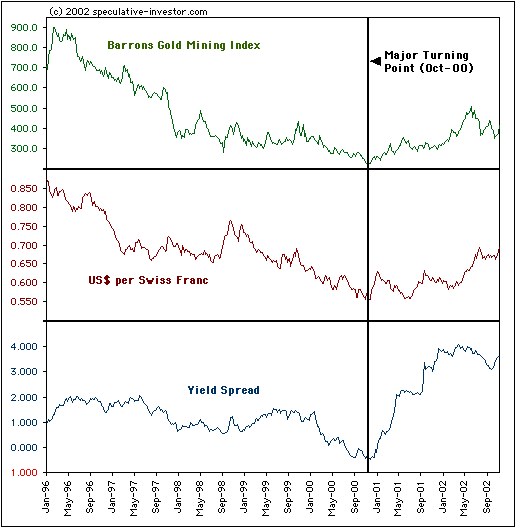
Gold Stocks,
Interest Rates and the US$
Here is an extract from commentary
that was posted at www.speculative-investor.com on 14th November 2002.
In recent commentaries we've spent
a lot of time discussing how interest rates influence the prices of gold
stocks. In particular, we've explained that it is the level of long-term
interest rates relative to short-term interest rates (the 'yield
spread'), rather than the absolute level of long-term interest rates,
that is of greatest importance to the prices of gold stocks.
When we talk about the 'yield spread'
we are referring to the yield on the 30-year T-Bond minus the yield on
the 13-week T-Bill. Over the period from 1982 to the present day the correlation
between the yield spread and gold stock prices (as represented by the Barrons
Gold Mining Index) was +0.29. This is a significant correlation and, in
rough terms, implies that the yield spread and gold stocks trended in the
same direction about 65% of the time. In recent years, however, the relationship
has become even stronger. In fact, since the beginning of 2000 the positive
correlation between the yield spread and the Barrons Gold Mining Index
(BGMI) has been an extremely-high 0.77 (implying that the 2 sets of data
have trended in the same direction about 88% of the time).
We can't be sure that the higher correlation
over the past 3 years means that there is now a permanently-stronger relationship
between the yield spread and the gold sector of the stock market. However,
since the relationship has been so strong during recent years it is certainly
worth paying close attention to the behaviour of the yield spread when
attempting to assess the gold sector's risk/reward ratio.
While the correlation between the yield
spread and gold stocks has varied widely over the past 30 years, the inverse
correlation between gold (and hence gold stocks) and the US$ has consistently
been strong since gold and the Dollar were officially de-linked in the
early-1970s. This is the case almost regardless of what period we select.
For example, over the past 30 years the correlation between the SF/US$
exchange rate (the number of US Dollars per Swiss Franc) and the gold price
was 0.79, whereas the correlation between the two over the past 12 months
was 0.74. In other words, the correlation between gold and the Dollar over
the past 12 months has not only been very high, it has been almost perfectly
in line with the long-term average.
The below chart shows how the Barrons
Gold Mining Index, the SF/US$ exchange rate and the yield spread have moved
in synch with each other since the beginning of 2000. (Thanks to Mark L
for his work to compile the Barrons Gold Index data)

We are certain that the gold market
is manipulated and we are quite sure that some of the world's major central
banks and governments have a hand in this manipulation. However, it is
clear that the manipulation has not prevented the inter-market relationships
that have worked well for the past 30 years from continuing to work well.
Therefore, although it is certainly possible that the gold price could
move higher for reasons that have nothing to do with the US$, it is highly
improbable.
At this stage the US$ appears to be
headed much lower. This, in turn, is a good reason to be very bullish on
the prospects for gold and gold stocks. When bond prices fall, thus causing
the yield spread to widen, this will create more upward pressure on the
prices of gold and gold stocks.
Regular financial market forecasts
and
analyses are provided at our web site:
http://www.speculative-investor.com/new/index.html
One-month free trial available.

|

